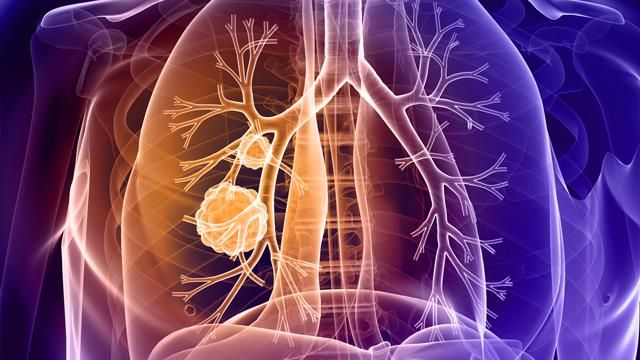Lung carcinoma is the leading cause of cancer-related death worldwide. In lung cancer, the healthy cell that becomes the tumor cell is in the epithelium lining the entire respiratory tree from the trachea to the thinnest terminal bronchiole. Symptoms may include cough, chest discomfort or pain, weight loss and less frequently hemoptysis (coughing up blood). Depending on the stage of the disease, treatment consists of surgery, chemotherapy, radiotherapy or a combination of some of these modalities.
Primary lung cancer is a cancer that originates from lung cells. It may start in the respiratory tracks that branch off from the trachea (windpipe) to ventilate the lungs (bronchi) or in the small air sacs of the lung (alveoli). Metastatic lung cancer is cancer that has spread from other parts of the body, most often from the breast, colon, prostate, kidneys, thyroid glands, stomach, cervix, rectum, testicles, bones or skin. Most patients do not see a doctor until they have the first symptoms and these vary depending on the stage of the disease. Diagnosis usually occurs because the tumor begins to interfere with nearby organs.
CAUSES:
The most important cause of lung cancer in about 85% of cases is smoking. The risk of lung cancer increases with combined exposure to toxins and smoking. Other risk factors include air pollution, marijuana use, exposure to carcinogens (asbestos, arsenic, nickel, chromates, among others). The risk of lung cancer associated with electronic nicotine delivery systems such as electronic cigarettes has not yet been determined, although it is believed that tobacco combustion products are the main carcinogens. Other causes also include genetic factors.
Respiratory epithelial cells require prolonged exposure to cancer-promoting agents and the accumulation of multiple genetic mutations before becoming neoplastic.
SYMPTOMS:
About 25% of lung cancer patients are asymptomatic and are detected mainly incidentally by chest x-ray. When symptoms begin to appear they are a consequence of the progression of the disease whether local, regional dissemination or metastasis. The manifestations of lung cancer generally depend on the stage of the disease. The initial stages are usually asymptomatic or with symptoms that can be confused with other diseases.
The most frequent symptoms are:
- Tiredness;
- Loss of appetite;
- Dry cough;
- Coughing up blood;
- Shortness of breath;
- Pain in bone structures;
- Other symptoms may arise from metastasis or invasion of tumor cells into the lymph nodes, bones, brain, liver and adrenal glands.
Lung cancer is classified according to what type of cells make up the tumor:
- Non-small cell lung cancer;
- Small cell or microcytic lung cancer. This is a very aggressive cancer that grows and spreads very quickly.
When the tumor is local it may cause cough and less frequently dyspnea due to respiratory track obstruction, post-obstructive atelectasis or pneumonia and parenchymal loss due to lymphangitic spread. In the case of pneumonia, it may present with fever. Some patients report vague or localized chest pain. Hemoptysis is less common, and blood loss is minimal, unless the tumor erodes into a major artery and causes massive hemorrhage, but as mentioned above hemoptysis only occurs in about 10% of patients.
When tumor spread is regional it can cause pleuritic chest pain or dyspnea due to the development of pleural effusion; hoarseness, resulting from tumor invasion of the laryngeal nerve; and dyspnea and hypoxia due to diaphragmatic paralysis, due to involvement of the phrenic nerve.
Over time metastases cause other symptoms that vary by location, metastases can spread to:
- Liver: causes pain, nausea, early satiety and even liver failure;
- Brain: causes behavioral changes, confusion, aphasia, seizures, paralysis, nausea and vomiting;
- Bones: can cause severe pain and pathological fractures;
- Adrenal glands: rarely with adrenal insufficiency.
Diagnosis is made through:
- Chest x-ray;
- Positron emission tomography;
- Cytopathologic examination of pleural fluid or sputum;
- Bronchoscopy-guided biopsy and core needle biopsy;
- Lung biopsy.
To determine the treatment for lung cancer, the size and location of the tumor must be taken into account. Depending on this, there are different types of treatment, including surgery, chemotherapy and radiotherapy.

In the case of lung cancer surgery, it involves the total or partial removal of the tumor from the lymph nodes near the thorax, depending on the type of intervention. There are three types of surgery: segmentectomy, lobectomy and pneumonectomy. The recovery period is several weeks or months.
Radiotherapy consists of eliminating cancer cells by means of high-energy ionizing radiation, which can stop their growth and division. This type of therapy can produce, to a greater or lesser extent, a series of side effects such as tiredness, difficulty in swallowing, coughing and slight respiratory difficulty.
Chemotherapy uses intravenous or oral drugs to destroy tumor cells. It is administered in cycles, alternating periods of treatment and rest. Depending on when it is administered, there are different types of chemotherapy. Chemotherapy drugs, like radiation therapy, can also damage healthy cells in the body.
Cuba has carried out numerous studies on the subject and has a treatment for lung cancer with monoclonal antibodies, CIMAVAX EFG and VAXIRA. Both vaccines offer the possibility of converting advanced cancer into a controllable chronic disease for those patients who are eligible for treatment. The vaccine has shown encouraging results in terms of survival and improvement in the patient’s quality of life, in addition to having no adverse side effects.
